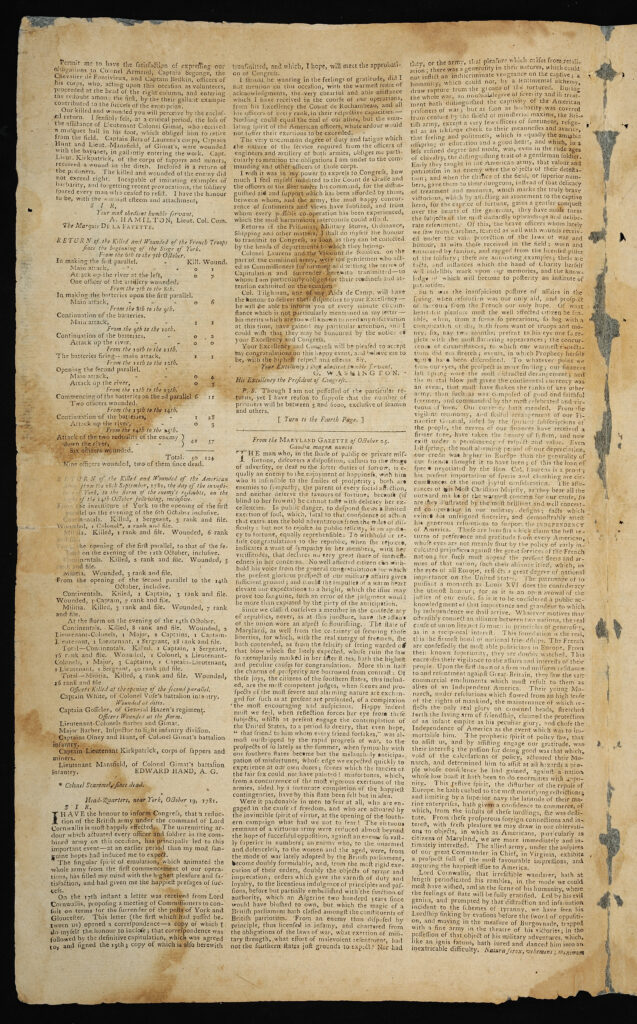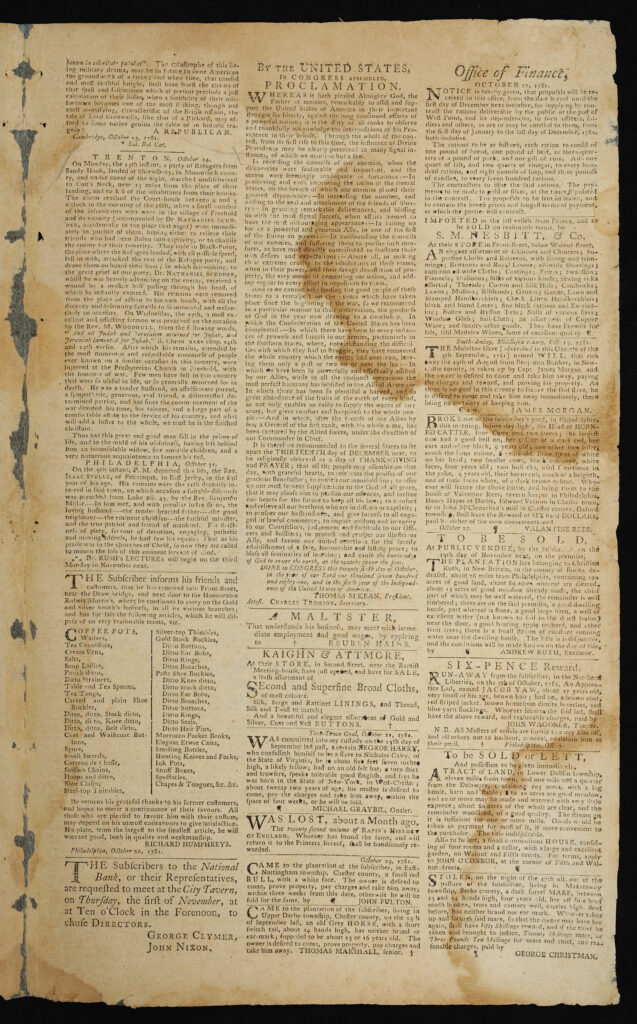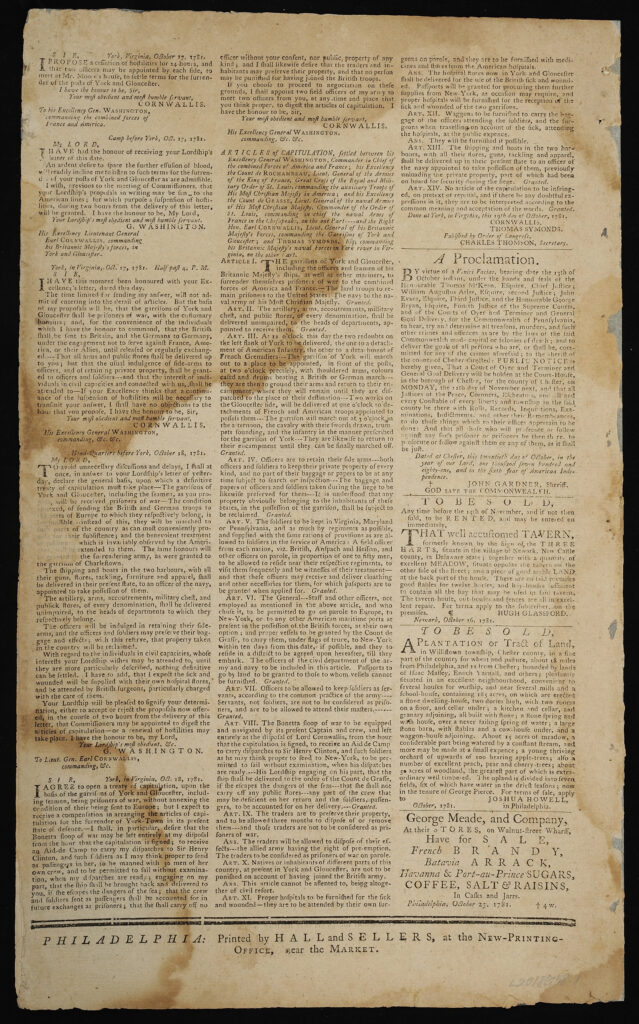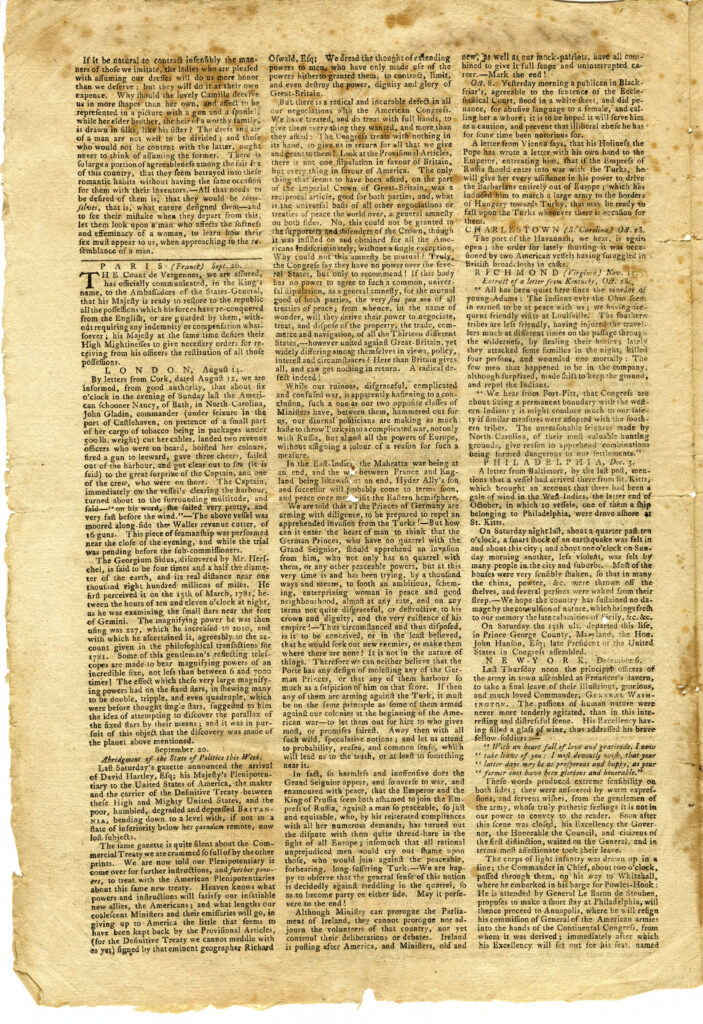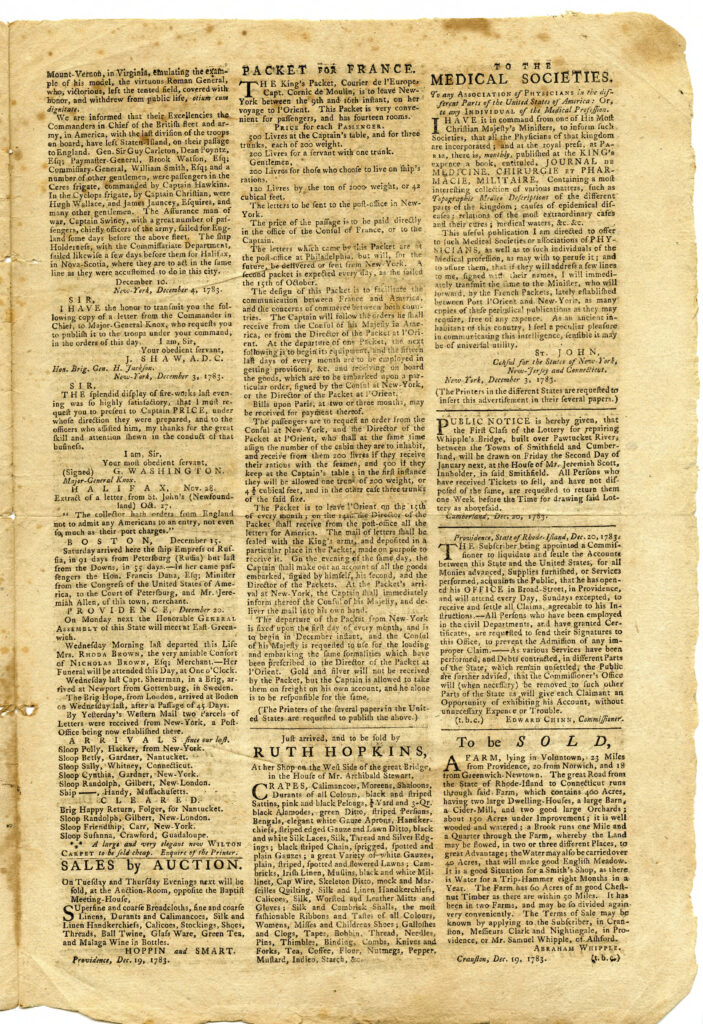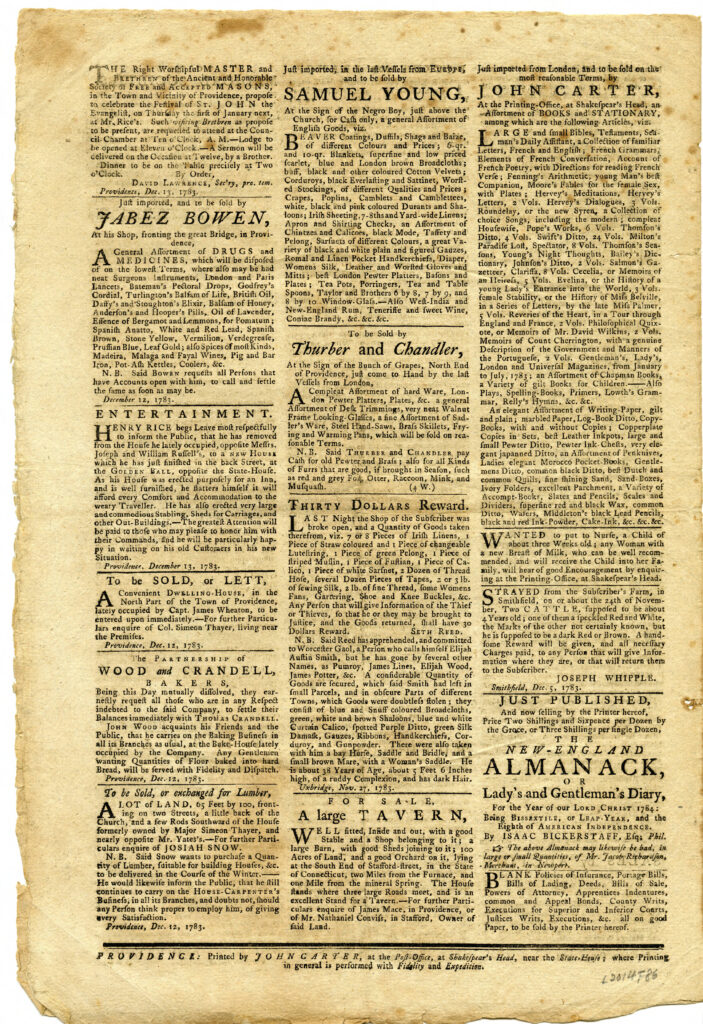Will Kelley, Kirby High School (Memphis-Shelby County Schools), Memphis, Tennessee
DESIGN LEVEL: Middle School-High School
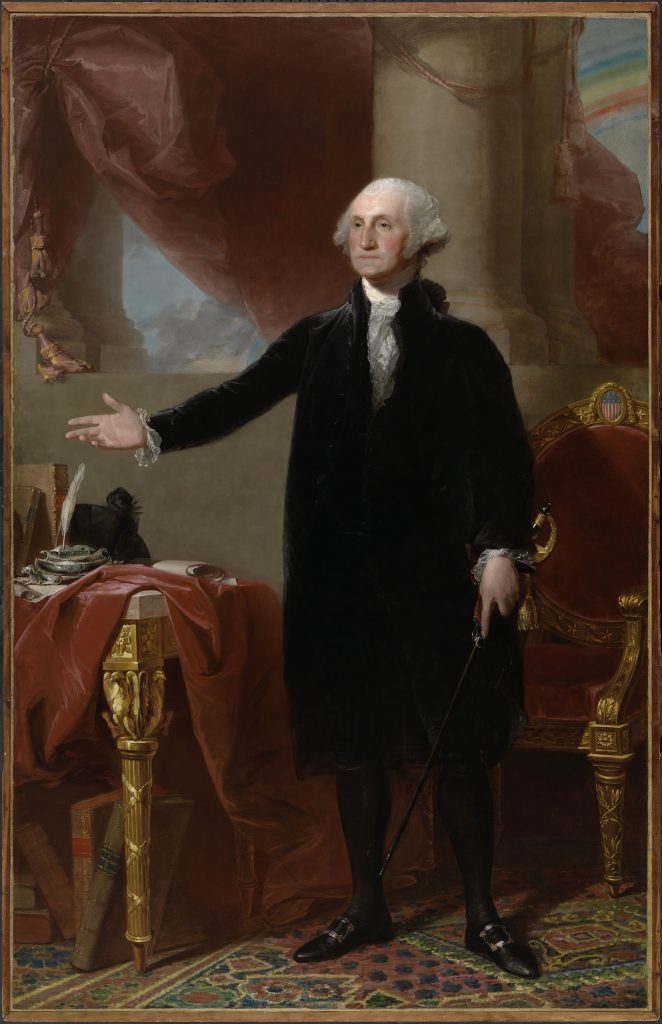
George Washington (Lansdowne Portrait) by Gilbert Stuart, 1796.
Overview
American ideas about executive power evolved during the Revolution. This lesson plan asks students to examine primary and secondary sources related to George Washington during and after the Revolutionary War to consider how the idealization of Washington’s words and deeds set the stage for the creation of the office of the American presidency—with Washington in mind to become the inaugural office holder. The goals of this lesson are for students to understand: how Washington was perceived to embody the ideas and ideals of executive power; how Washington’s words and actions were lionized into mythos; and how the framers struggled with the concept of monarchy.
Objectives
Students will:
- learn how the American people struggled to differentiate themselves from England and move away from a monarchy,
- understand how George Washington’s actions during and after the Revolution came to embody the standard for executive power in the American republic, and
- how the idealization of Washington made him the embodiment of the American presidency.
Materials
- George Washington, Farewell Address, September 19, 1796.
- George Washington to David Rittenhouse, February 16, 1783.
- George Washington to Mercy Otis Warren, June 4, 1790.
- William Judd. D.S. Oath of allegiance. Fort Arnold, W. Point, May 13th, 1778.
- General Orders for the Army under the Command of Brigadier General M’Dougall… Concerning the Means of Preserving Health. Fishkill, N.Y.: Samuel Loudon, 1777.
- The Pennsylvania Gazette (no. 2681), October 31, 1781 (see gallery below).
- The Providence Gazette and Country Journal (v. 20, no. 1042), December 20, 1783.
- United States Constitution, Article II, 1787.
Recommended Time
Two 50-minute class periods.
Activity
Day 1:
Students will begin the lesson by establishing their baseline knowledge of George Washington’s persona and achievements in a basic warm up activity, such as journaling. Students will then engage in a discussion where they compare their background knowledge of George Washington and build their knowledge in a think/pair/share-style activity.
After the think/pair/share, students will be placed into groups, then introduced to the sources provided. Students will examine, catalogue and categorize what the resources contain and start listing the main points or main ideas of the resources. The groups will end the lesson by sharing the main points their group gathered with the class.
Day 2:
Students will compare the knowledge gained from the resources provided on the previous day (perhaps in a jigsaw activity). Either in groups or individually, they will use the information from those resources to create a “Help Wanted” advertisement looking for a President, using the criteria provided by Washington’s words and actions. Students can create these ads traditionally via paper and pencil or in a digital format. Students will then conduct a gallery walk, critiquing one another’s wanted ads.
Assessment
A rubric created by instructor relative to the information gathered from each source will be used to assess student work as expressed in their advertisement during the gallery walk.
Extension
Students can use the resources as the basis for a research paper on Washington’s role as a founder of the United States, the duties and responsibilities of the American presidency, and other related topics.
Standards Addressed
COMMON CORE: English Language Arts Standards—History/Social Studies
CCSS.ELA-LITERACY.RH.9-10.1
Cite specific textual evidence to support analysis of primary and secondary sources, attending to such features as the date and origin of the information.
CCSS.ELA-LITERACY.RH.9-10.2
Determine the central ideas or information of a primary or secondary source; provide an accurate summary of how key events or ideas develop over the course of the text.
CCSS.ELA-LITERACY.RH.9-10.3
Analyze in detail a series of events described in a text; determine whether earlier events caused later ones or simply preceded them.
CCSS.ELA-LITERACY.RH.11-12.1
Cite specific textual evidence to support analysis of primary and secondary sources, connecting insights gained from specific details to an understanding of the text as a whole.
CCSS.ELA-LITERACY.RH.11-12.2
Determine the central ideas or information of a primary or secondary source; provide an accurate summary that makes clear the relationships among the key details and ideas.
CCSS.ELA-LITERACY.RH.11-12.3
Evaluate various explanations for actions or events and determine which explanation best accords with textual evidence, acknowledging where the text leaves matters uncertain.
CCSS.ELA-LITERACY.RH.11-12.7
Integrate and evaluate multiple sources of information presented in diverse formats and media (e.g., visually, quantitatively, as well as in words) in order to address a question or solve a problem.
CCSS.ELA-LITERACY.RH.11-12.8
Evaluate an author’s premises, claims, and evidence by corroborating or challenging them with other information.
CCSS.ELA-LITERACY.RH.11-12.9
Integrate information from diverse sources, both primary and secondary, into a coherent understanding of an idea or event, noting discrepancies among sources.
TENNESSEE STATE SOCIAL STUDIES STANDARDS—July 2017
TN 8.23 Examine the principles and purposes of government articulated in the Preamble and principles stated in the Constitution, including: the separation of powers, federalism, and checks and balances.
TN GC. 06 Describe limited government within the Constitution, including:
• Checks and balances • Popular sovereignty • Civilian control of the military • Rule of law • Federalism • Separation of powers • Judicial review
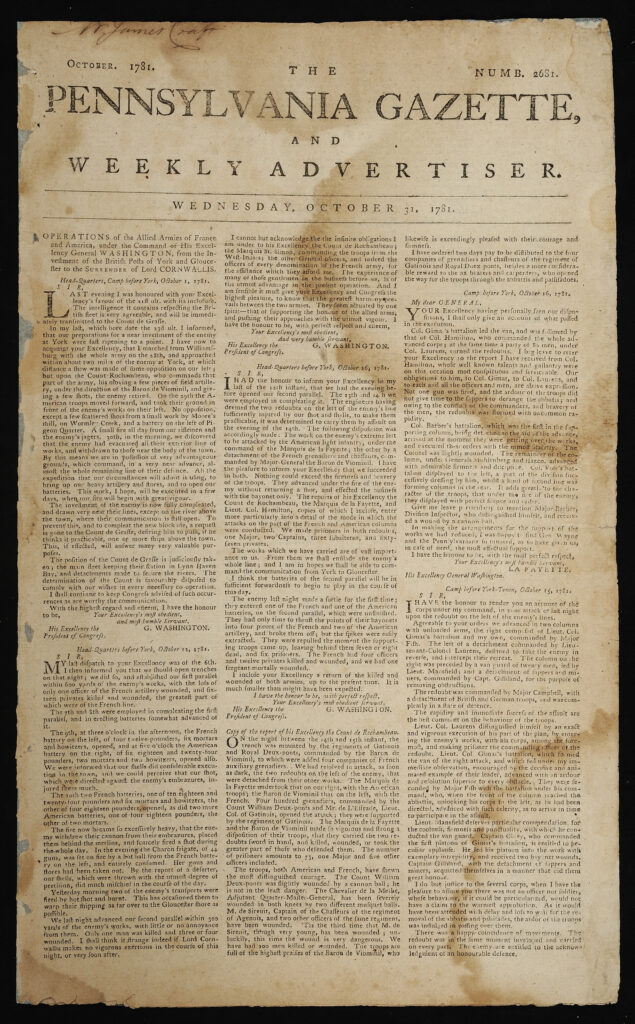
The Pennsylvania Gazette
Philadelphia: Samuel Kleimer, October 31, 1781The Hamilton Newspaper and Ephemera Collection of Antonia Chambers, Esq.
This paper, published just twelve days after the British surrender at Yorktown, includes many letters to and from George Washington about the siege. The account of Alexander Hamilton’s valiant performance is one of the earliest appearances of his name in the press. Also highlighted are the actions of John Laurens, the comte de Rochambeau and the marquis de Lafayette. Additionally, this paper published a “Return of the Killed and Wounded of the French Troops” and a “Return of the Killed and Wounded of the American Army.” A series of letters between Washington and Cornwallis, and the Articles of Capitulation, ends this issue.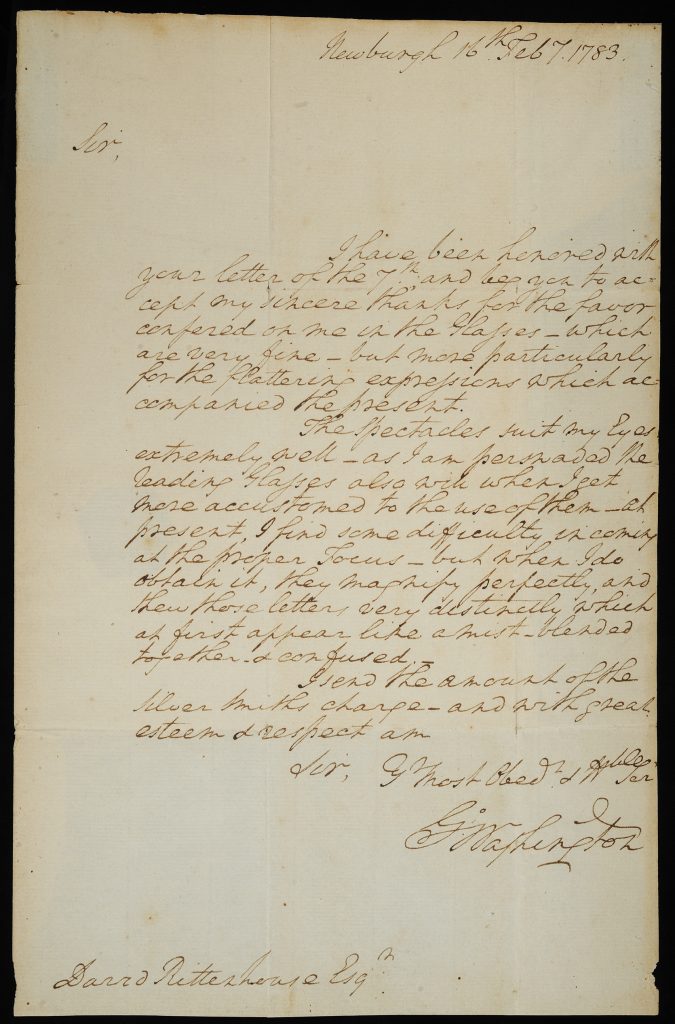
George Washington to David Rittenhouse
February 16, 1783The Society of the Cincinnati, Gift of George Miller Chester, Jr., in honor of his great-great-great-great grandfather, Col. John Chester, 2015
George Washington wrote a letter of thanks to noted American inventor and instrument maker David Rittenhouse for making him a set of spectacles (one for distance and one for reading). "The Spectacles suit my Eyes extremely well," Washington wrote, "as I am persuaded the Reading Glasses also will when I get more accustomed to the use of them - at present, I find some difficulty in coming at the proper Focus - but when I do obtain it, they magnify perfectly, and shew those letters very distinctly which at first appear like a mist blended together & confused." Three weeks later the reading glasses would be used to great effect when Washington, in attempting to quell a brewing mutiny of officers at Newburgh, pulled them from his pocket and said "Gentlemen, you must pardon me. I have grown gray in your service and now find myself growing blind."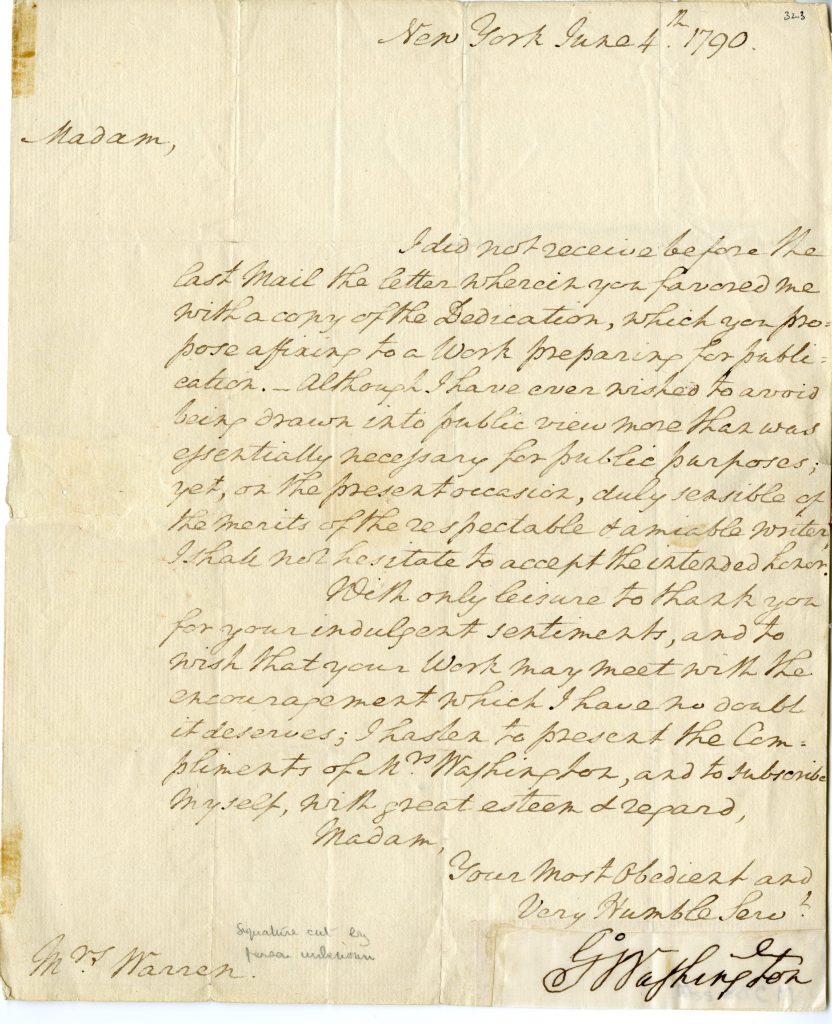
George Washington to Mercy Otis Warren
June 4, 1790The Society of the Cincinnati, Gift of Charles Warren, 1947
George Washington writes Mercy Otis Warren to accept the dedication in her book Poems, Dramatic and Miscellaneous (Boston, 1790) and wishes Warren well. Washington's signature was clipped and is supplied in facsimile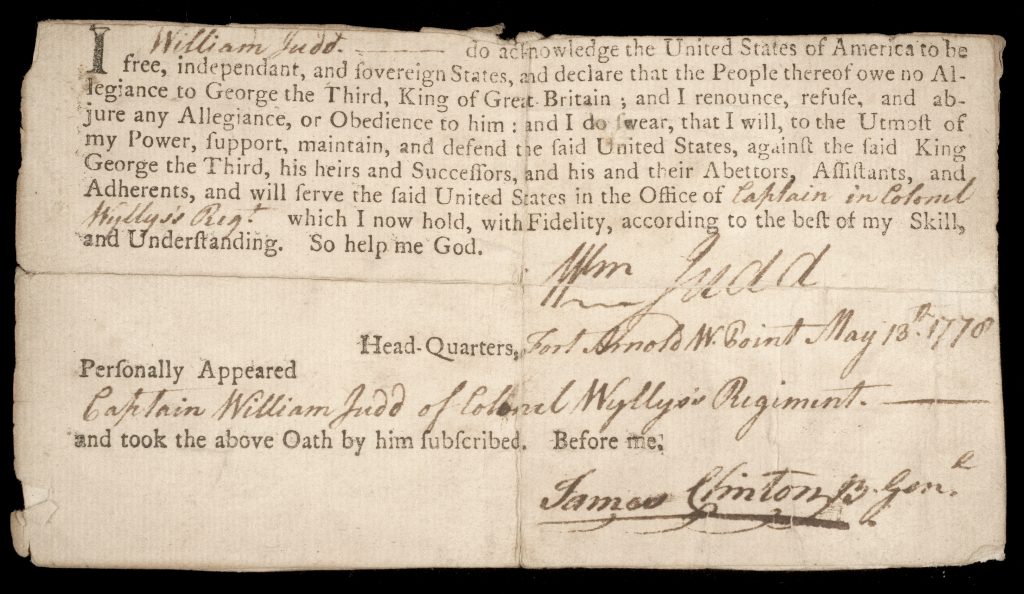
William Judd Oath of Allegiance
Fort Arnold, West Point, May 13, 1778The Society of the Cincinnati, Gift of Diana Judd Stevens, Martha Judd Estroff, William Hart Judd III, Margaret Ann Judd, and Rebecca Judd, in memory of their grandfather, William Hart Judd, and father William Hart Judd, Jr.
Oath of allegiance of William Judd acknowledging "the United States of America to be free, independent, and sovereign States" and swearing to "support, maintain, and defend said States against the said King George the Third.." and serving "in the office of Captain in Colonel Wyllys's Regt." Signed "James Clinton, B. Genl" that Judd personally appeared before him to take the oath.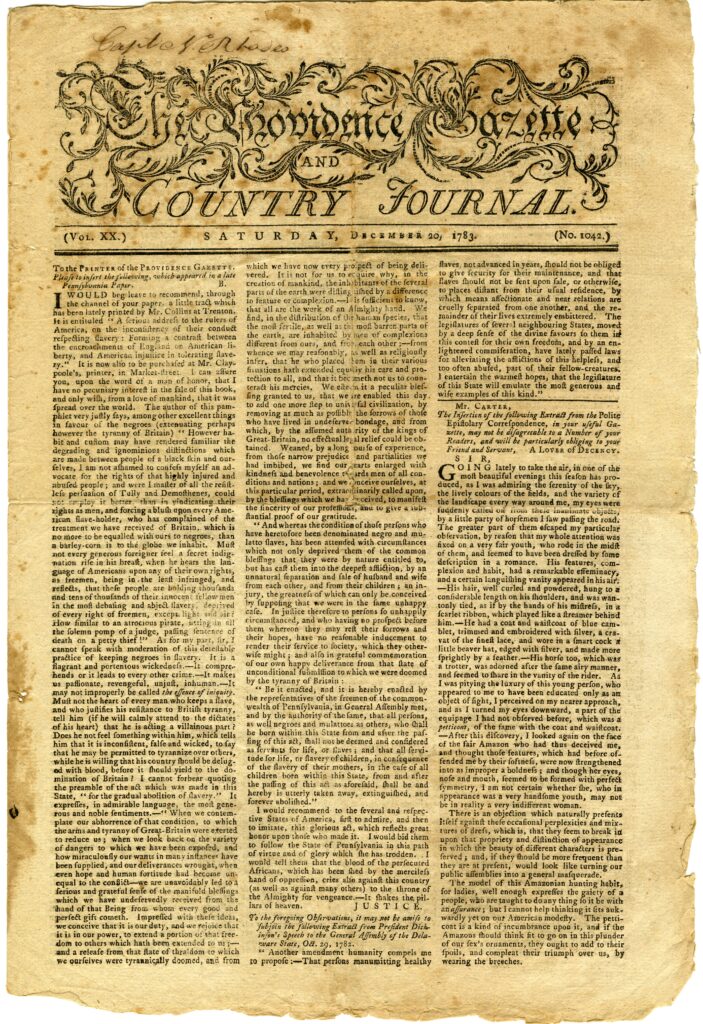
The Providence Gazette and Country Journal
Providence: W. Goddard, December 20, 1783The Robert Charles Lawrence Fergusson Collection
This issue reports on George Washington’s farewell to officers at Fraunces Tavern, recounting his speech and detailing his upcoming travels to Whitehall, Paulus Hook, Philadelphia and Annapolis, comparing his travel home to Cincinnatus: “immediately after which his Excellency will set out for his seat, named Mount-Vernon, in Virginia, emulating the example of his model, the virtuous Roman General, who, victorious, left the tented field, covered with honor, and withdrew from public life, otium cum dignitate.” Additionally, this issue features a reprinting of a British editorial critical of the Treaty of Versailles.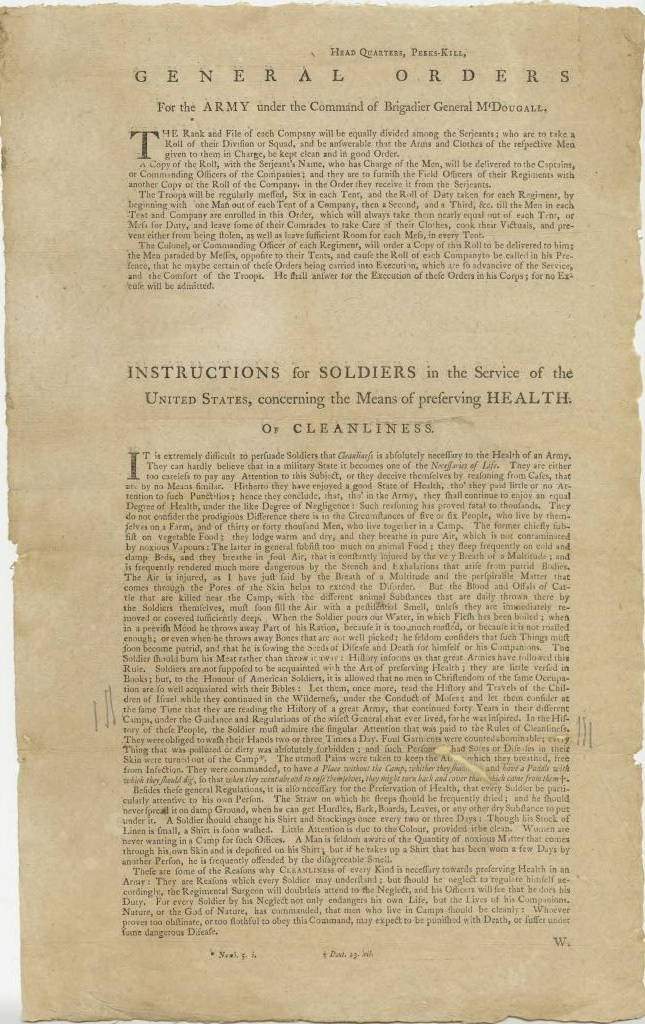
General orders for the Army under the Command of Brigadier General M' Dougall ... Instructions for Soldiers in the Service of the United States, concerning the Means of preserving Health of Cleanliness
George Washington
Fishkill, New York, 1777The Society of the Cincinnati
From his earliest days of command, George Washington emphasized order and cleanliness in camp. His general orders were codified in the official manual of the Continental Army, Regulations for the Order and Discipline of the Troops of the United States, written by Gen. Friedrich Wilhelm Steuben in 1779 following the brutal winter at Valley Forge.